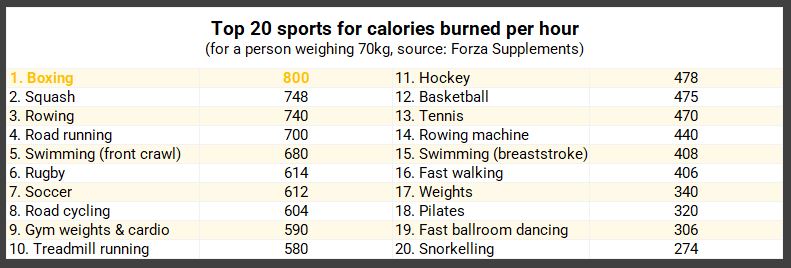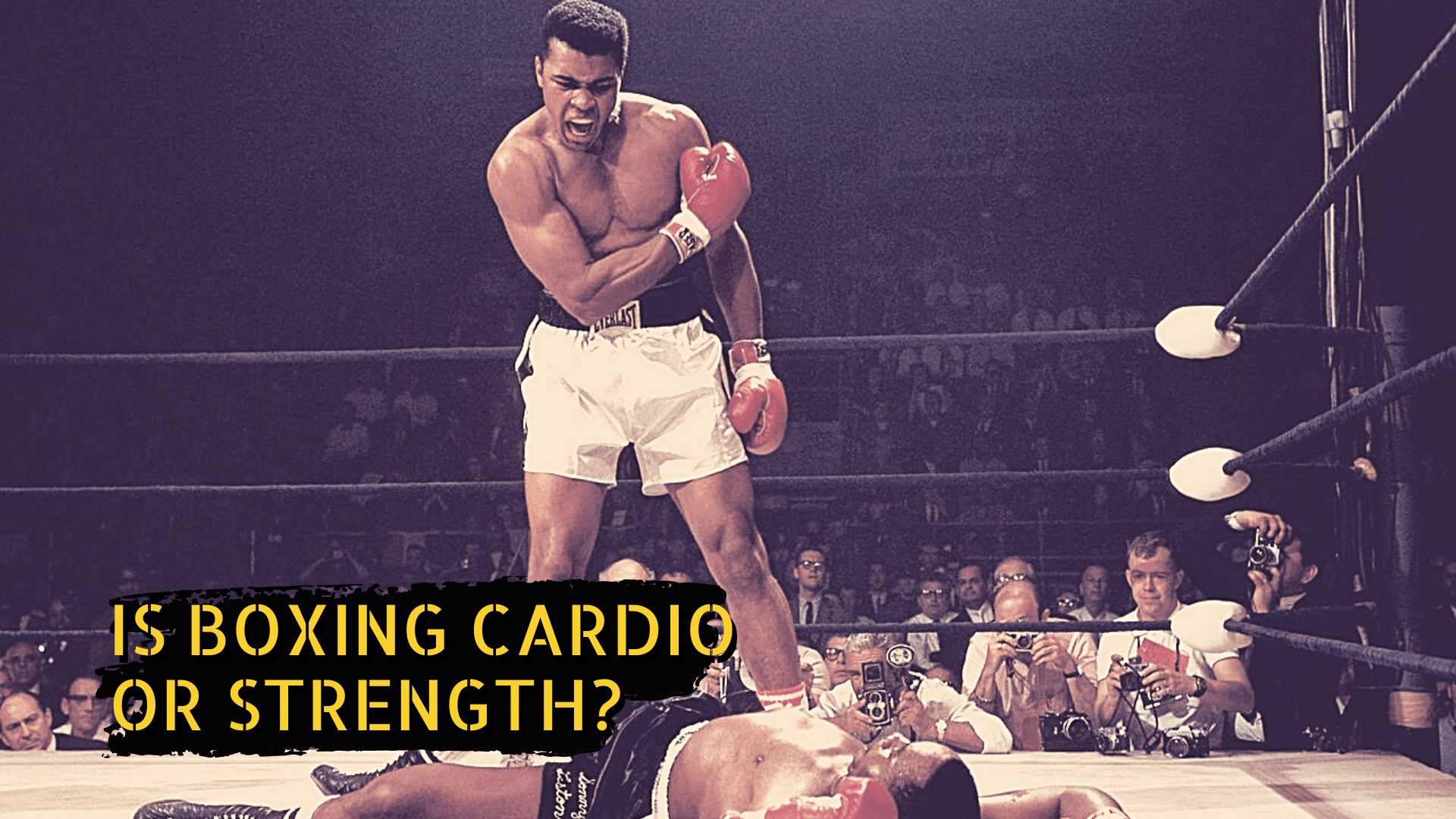I’ve tried a lot of intense sports, like squash, rowing, and endurance running. I can safely say that none chew me up and spit me out quite like an hour of boxing. It’s cardio, it’s strength, it’s psychological, it’s endurance. It’s everything. And we’ve looked into the research to prove it. Let’s dive in.
Boxing is a very high intensity sport that provides an excellent, full-body cardiovascular work-out. Studies have shown that it burns more calories than any other sport. Of course, boxers also need to have muscular strength for powerful punches. Although, interestingly, research has shown that lower body strength is a bigger driver of punch power than upper body strength.
Is boxing cardio or strength? 🥊
Every one of my boxing sessions starts with 7 minutes jumping rope. Followed by at least another 20 minutes of both cardio and strength exercises before we even put the gloves on.
The reason for this is simple. Boxers need to be able to condition their bodies to deal with intense, explosive yet prolonged exertion (i.e. cardio), but also have punching power to hurt their opponent (i.e. strength).
A spindly marathon runner without any strength will not be a good boxer, neither will a jacked body-builder who has only ever focussed on lifting weights. Boxing requires a hefty dose of both cardiovascular fitness and muscular strength. So, boxing training will ensure both of these aspects are well addressed.
Don’t believe me? Ask the brainboxes over at Harvard Medical School
Boxing and cardio training 💓
It’s clear to anyone who has watched or tried boxing that it sends the heartrate through the roof. It involves numerous rounds of high-intensity, full-body, nauseatingly-exhausting effort. But what does the research say about boxing as a form of cardio exercise?
A study done by Forza shows that boxing burns more calories per hour then any other sport, including football and basketball:

I once weighed myself before and after a 1 hour training session and found that I had lost 1.5 kg in sweat!
We found another scientific study published in the Journal of Sports Medicine that analysed the heart rate of 10 Olympic boxers. It showed that
“the average intensity of a simulated boxing match was very severe, as an appreciable percentage (~60%) of the exercise bout occurred at an intensity greater than the ventilatory threshold”
The ventilatory threshold is the point at which oxygen delivery to the muscles becomes a limiting factor, and your body is forced to rely more upon its anaerobic energy system.
The evidence is pretty clear. If you’re looking for an exercise to improve your cardiovascular fitness (I.e. the health of your heart and blood vessels) or lose weight then boxing is for you.
Related articles:
Why is cardio fitness important for boxing? 🏃🏽
No doubt you’ve seen those videos of boxers running through city streets in the dead of night or jumping rope at the speed of light. This is to improve cardio fitness which is crucial to the success of a fighter. Cardio fitness allows boxers to fight longer and harder.

Why?
When you exercise, your muscles consume oxygen to produce energy and perform the tasks you need like moving or punching. Cardio training is all about increasing the amount of oxygen your body can deliver to your muscles so they can produce more energy.
Through cardio training you increase your body’s capacity to deliver oxygen to your muscles so that they can work longer without getting tired.
This is obviously crucial when you’re in the ring fighting, burning through huge amounts of energy, and using all your muscles. If a fight drags into the later rounds, the fitter fighter will almost certainly come out on top as they have more energy to keep punching and protecting themselves.
How does cardio training improve out fitness?
- Through cardio exercise our hearts grow stronger, enabling more blood (and therefore oxygen) to be delivered to our muscles with each heartbeat
- Our muscles get more efficient at converting oxygen into useful energy
- Our lung capacity increases, meaning we can get more oxygen into our blood with each breath
Boxing and strength training 💪
Of course, boxers need to be strong. You’re going to have a hard time knocking your opponent down if you’re built like a wire clothes hanger. So, most decent boxing gyms will incorporate weight training of some sort into their classes.
And it’s not just your arms, but also your shoulders, back, core, legs. Boxing truly demands something of your whole damn body.
But boxing weight training looks very different to someone looking to bulk up ahead of their summer vacation.
As well as being strong, boxers also need to be mobile and explosive, so boxing strength training focuses on developing lean muscles rather than big muscles, as well as injury prevention. Check out the vid below of lightweight champion Devin Haney.
For example, some of our most common strength training exercises at my boxing gym are push-ups and shadowboxing with 2kg dumbbells. Low weight, high reps to build lean, explosive muscle. There is evidence to suggest that weightlifting can reduce speed so some trainers prefer their fighters not to do much weight lifting.
Yes, some boxers do lift weights, but if your primary goal of training is to get pecks that burst out of your t-shirt then you’re in the wrong place.
How important is strength for boxing? 🏋️
Generally speaking, the stronger you are, the harder you’ll punch. And in boxing that’s a good thing (although strength is just one of multiple important characteristics that a great boxer must posses alongside speed, grit, technique etc etc). However, what is less well understood is the importance about where a boxer needs to be strong.
The importance of lower-body strength
You might think that upper body strength, such as arms and shoulders, is most important given this is where the punching action happens. You’d be wrong.
This academic study of 28 highly trained amateur boxers showed that lower-body strength makes a much larger contribution to overall punch strength than upper body. The study even suggests that upper body strength has little effect on punching power:
“Lower-limb strength is strongly related to peak punch force production in well-trained boxers and may be a key contributor to the delivery of a high force punch… and upper-body strength and power characteristics may not be discriminating factors relating to punch force”
Why?
When you punch, the first force exerted is actually on the ground by your feet and legs to give you the momentum into the punch and drive you forward. If you have a strong lower body, you can propel your whole body forward with more force, giving you a much harder punch. Try punching with both feet next to each other flat on the floor and you’ll see what I mean.
Like most things in boxing, it all starts with your stance and with your legs. Don’t skip leg day!
Strength doesn’t always equal punching power
Curiously, there is research to suggest that strength doesn’t always equate to stronger punches. This study shows that upper body strength, as measured by maximum weight bench-pressed, is positively correlated to punching power with the rear arm but not with the lead arm (jab arm).
Why? Most likely because the force of a jab is determined by explosive power and technique, rather that sheer brute force.


What other benefits are there of boxing? ❓
By now you’ve probably got the message that boxing is one hell of a physical work-out. But the benefits of the sport don’t stop there. Here are some of the other reasons I’ve been boxing for six years:
- Mental health – boxing develops your inner peace and relieves stress
- Confidence – boxing will change the way you carry yourself and the improvement in your self-esteem will manifest in all aspects of your life
- Self-defense – learn how to protect yourself and your loved ones if some clown tries it on
- Fun – the adrenaline rush of being in a boxing fight is unlike anything else
- Community – there’s nothing like punching each other in the face as a way to build strong personal bonds
12th Round 🔔
The evidence is clear, boxing brings huge benefits for both cardiovascular health and muscular strength. It really is the ultimate all-round exercise for a healthy heart and full-body strength. If you’re considering giving the sport a try, just go for it, trust me!
Happy fighting! 🥊🥊
“I made a lot of mistakes out of the ring, but I never made any in it.”
— Jack Johnson


